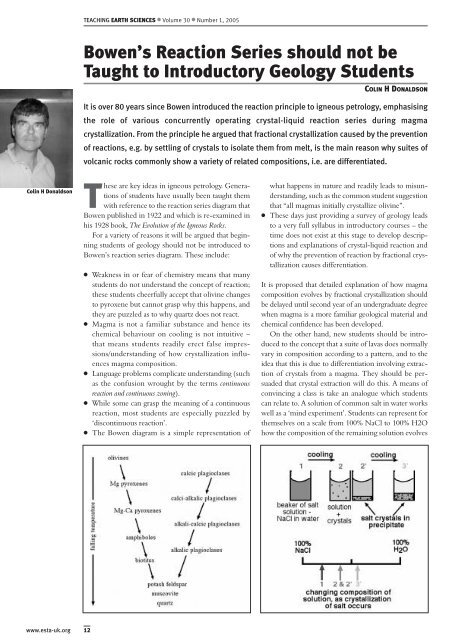teaching - Earth Science Teachers' Association
teaching - Earth Science Teachers' Association
teaching - Earth Science Teachers' Association
- No tags were found...
You also want an ePaper? Increase the reach of your titles
YUMPU automatically turns print PDFs into web optimized ePapers that Google loves.
TEACHING EARTH SCIENCES ● Volume 30 ● Number 1, 2005<br />
Bowen’s Reaction Series should not be<br />
Taught to Introductory Geology Students<br />
COLIN H DONALDSON<br />
It is over 80 years since Bowen introduced the reaction principle to igneous petrology, emphasising<br />
the role of various concurrently operating crystal-liquid reaction series during magma<br />
crystallization. From the principle he argued that fractional crystallization caused by the prevention<br />
of reactions, e.g. by settling of crystals to isolate them from melt, is the main reason why suites of<br />
volcanic rocks commonly show a variety of related compositions, i.e. are differentiated.<br />
Colin H Donaldson<br />
These are key ideas in igneous petrology. Generations<br />
of students have usually been taught them<br />
with reference to the reaction series diagram that<br />
Bowen published in 1922 and which is re-examined in<br />
his 1928 book, The Evolution of the Igneous Rocks.<br />
For a variety of reasons it will be argued that beginning<br />
students of geology should not be introduced to<br />
Bowen’s reaction series diagram. These include:<br />
● Weakness in or fear of chemistry means that many<br />
students do not understand the concept of reaction;<br />
these students cheerfully accept that olivine changes<br />
to pyroxene but cannot grasp why this happens, and<br />
they are puzzled as to why quartz does not react.<br />
● Magma is not a familiar substance and hence its<br />
chemical behaviour on cooling is not intuitive –<br />
that means students readily erect false impressions/understanding<br />
of how crystallization influences<br />
magma composition.<br />
● Language problems complicate understanding (such<br />
as the confusion wrought by the terms continuous<br />
reaction and continuous zoning).<br />
● While some can grasp the meaning of a continuous<br />
reaction, most students are especially puzzled by<br />
‘discontinuous reaction’.<br />
● The Bowen diagram is a simple representation of<br />
what happens in nature and readily leads to misunderstanding,<br />
such as the common student suggestion<br />
that “all magmas initially crystallize olivine”.<br />
● These days just providing a survey of geology leads<br />
to a very full syllabus in introductory courses – the<br />
time does not exist at this stage to develop descriptions<br />
and explanations of crystal-liquid reaction and<br />
of why the prevention of reaction by fractional crystallization<br />
causes differentiation.<br />
It is proposed that detailed explanation of how magma<br />
composition evolves by fractional crystallization should<br />
be delayed until second year of an undergraduate degree<br />
when magma is a more familiar geological material and<br />
chemical confidence has been developed.<br />
On the other hand, new students should be introduced<br />
to the concept that a suite of lavas does normally<br />
vary in composition according to a pattern, and to the<br />
idea that this is due to differentiation involving extraction<br />
of crystals from a magma. They should be persuaded<br />
that crystal extraction will do this. A means of<br />
convincing a class is take an analogue which students<br />
can relate to. A solution of common salt in water works<br />
well as a ‘mind experiment’. Students can represent for<br />
themselves on a scale from 100% NaCl to 100% H2O<br />
how the composition of the remaining solution evolves<br />
www.esta-uk.org<br />
12
















